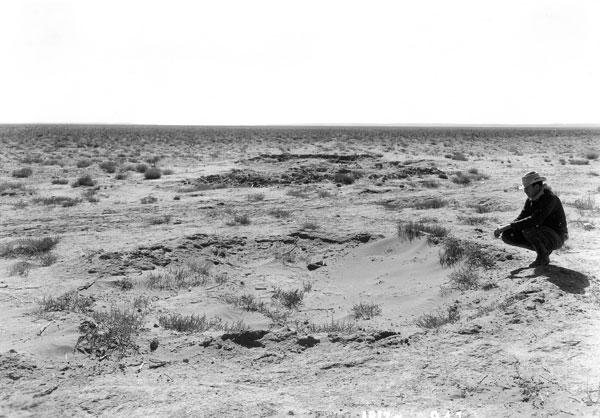-Press Kit-

Milton Snow, Two sites of former hogans. Fartherest [sic] occupied this year, nearest one occupied this year. Red Lake (Tolani Lakes, Leupp, Arizona), 1935-1936. Reproduction of archival photograph, Maxwell Museum of Anthropology Archives, 87.45.116
Exhibit Summary: Using the photograph as a site of inquiry, this exhibition examines the impact of U.S. Indian Commissioner John Collier’s brutal Navajo Livestock Reduction Program on Diné communities and homelands.
Imposed upon Navajo people in the 1930s, this federal program proposed to eliminate over half of Diné livestock herds. Against the backdrop of the Dust Bowl and the Hoover Dam, livestock reduction was an extreme response to reports of over-grazing throughout Diné Bikéyah, the Navajo homeland. Collier’s policies were carried out in ignorance of Diné land management practices and community needs. Imprisoned for resisting, Diné people were forced to watch their livelihoods decimated as their sacred animals were taken from them. Livestock reduction resulted in widespread, harmful, and longterm sociocultural, environmental, economic, and political changes throughout Diné Bikéyah.
Diné communities resisted livestock reduction policies. They saw their domestic animals as gifts from the Holy People, who offered them as the foundation for the Diné way of life. As a result of Collier’s tool of colonial control, Navajo people were no longer able to care for their land, their communities, and their herds in the ways they always had. In reflecting on this period, Marilyn Help (Diné) says, “You people…are heartless. You have now killed me. You have cut off my arms. You have cut off my legs. You have taken my head off. There is nothing left for me.”
Hired by the Navajo Service in 1937, non-Native photographer Milton Snow (1905–1986) was instructed to document the the federal government’s supposedly well-intentioned program to address “the Navajo problem.” Over the course of twenty years, Snow produced thousands of images of Diné people, homes, and landscapes, all of which were intended to provide proof that federal technologies were in fact working to “rehabilitate” Navajo lands and lives. Instead, Snow’s photographs show us radically harmed and altered communities, landscapes, and homes. We see the construction of dams, mines, and imposed grazing and agricultural practices; and newly formed political, educational, and socioeconomic organizations, all of which point to the pervasive, oppressive nature of American colonial administration.
By placing Snow’s images in conversation with a selection of archival documents and contemporary photographs, this exhibition foregrounds Diné perspectives on the intersecting and ongoing legacies of both photography and American colonialism.
Opening Reception: Please join us at the Maxwell Museum of Anthropology at the University of New Mexico (500 University Blvd NE) on Saturday, May 4, 2024, from 3-5 pm for an opening reception. Exhibition co-curator Dr. Jennifer Nez Denetdale (Diné) will give a brief lecture from 3:30-4 pm, and refreshments will be provided throughout the event.
Contact: For questions or more information, please contact the Maxwell’s Curator of Public Programs Julián Antonio Carrillo (jac123@unm.edu) and exhibition co-curator Lillia McEnaney (mcenaneylillia@gmail.com).